IN BRIEF by Kathleen L. Farquharson [email protected]
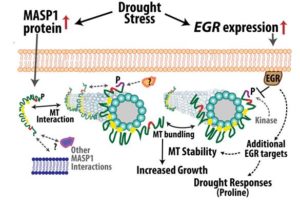 Limiting shoot growth is an important survival strategy for plants during times of drought; smaller leaves mean that less water is lost through transpiration and more is retained in the soil. As drought stress restricts both cell division and expansion – processes that rely on specialized microtubule arrays – factors that regulate microtubule organization and stability likely affect a plant’s ability to grow in dry conditions. However, the signaling pathways that link drought stress with changes in microtubule organization are unknown.
Limiting shoot growth is an important survival strategy for plants during times of drought; smaller leaves mean that less water is lost through transpiration and more is retained in the soil. As drought stress restricts both cell division and expansion – processes that rely on specialized microtubule arrays – factors that regulate microtubule organization and stability likely affect a plant’s ability to grow in dry conditions. However, the signaling pathways that link drought stress with changes in microtubule organization are unknown.
Now, Bhaskara et al. (2017) report a signaling module in Arabidopsis thaliana that influences microtubule organization and regulates plant growth, particularly during prolonged exposure to drought stress. Prompted by the finding that several Type 2C protein phosphatases (PP2Cs) function in drought signaling (Bhaskara et al., 2012; Cutler et al., 2010; Schweighofer, 2004), the authors identified three closely related PPC2s (EGRs) that inhibited plant growth and were dramatically induced by drought stress. Phosphoproteomic analysis revealed 17 putative EGR targets, many of which had established roles in cytoskeleton regulation or vesicle trafficking. The authors focused on one of these targets [which they named Microtubule Associated Stress Protein 1 (MASP1)], due to its massive increase in abundance in drought-stressed plants.
In contrast to the EGR protein phosphatases, MASP1 was found to promote growth, both under control and drought stress conditions. The authors showed that MASP1 associated with EGR proteins at the cell periphery. Given the enrichment of cytoskeleton-related proteins among the putative EGR targets, the authors then used lines expressing GFP-tagged a-tubulin to examine if EGR and MASP1 regulate microtubule organization. In agreement with previous reports (Mei et al., 2012 and Fujita et al., 2013), the authors found that cortical microtubule arrays became disorganized within a few hours of exposure to drought stress and partially recovered over the next few days. Strikingly, plants that overexpressed MASP1 or lacked EGR phosphatases had more stable microtubule arrays and exhibited more rapid recovery of microtubule organization under drought stress conditions. Further analysis showed that MASP1 associates with microtubules in vitro. In planta, MASP1 phosphorylation at S670 is critical for growth promotion and microtubule stabilization. Finally, epistasis tests indicated that EGRs and MASP1 function in a common pathway, with MASP1 acting downstream of EGRs.
Based on these findings, the authors developed a model in which EGR phosphatases and MASP1 regulate microtubule stability during drought stress, with the former reducing and the latter promoting microtubule stability and anisotropic cell expansion (see figure). Fine-tuning the activity of these two opposing sets of proteins may improve plant growth and yield during moderate drought.
References
Bhaskara, G.B., Nguyen, T.T., Verslues, P.E. (2012) Unique drought resistance functions of the highly ABA-induced clade A protein phosphatase 2Cs. Plant Physiol. 160: 379-395.
Bhaskara, G.B., Wen, T.-N., Nguyen, T.T., Verslues, P.E. Protein Phosphatase 2Cs and Microtubule-Associated Stress Protein 1 Control Microtubule Stability, Plant Growth, and Drought Response. Plant Cell 10.1105/tpc.116.00847.
Cutler, S.R., Rodriguez, P.L., Finkelstein, R.R., and Abrams, S.R. (2010). Abscisic Acid: Emergence of a Core Signaling Network. Annual Review of Plant Biology, 61: 651-679.
Fujita, S., Pytela, J., Hotta, T., Kato, T., Hamada, T., Akamatsu, R., Ishida, Y., Kutsuna, N., Hasezawa, S., Nomura, Y., Nakagami, H., and Hashimoto, T. (2013). An Atypical Tubulin Kinase Mediates Stress-Induced Microtubule Depolymerization in Arabidopsis. Current Biology 23: 1969-1978.
Mei, Y., Gao, H.B., Yuan, M., and Xue, H.W. (2012). The Arabidopsis ARCP Protein, CSI1, Which Is Required for Microtubule Stability, Is Necessary for Root and Anther Development. Plant Cell 24: 1066-1080.
Schweighofer, A., Hirt, H., and Meskiene, L. (2004). Plant PP2C Phosphatases: Emerging Functions in Stress Signaling. Trends in Plant Science 9: 236-243.
 Our way of life depends on the chemical manufacture of thousands of products. Some of these can be produced through biomanufacturing, which may involve starting with a biological starting material, or using an enzyme or organism as catalyst. Advances in synthetic biology, metabolic engineering and genomics have all provided new opportunities for biomanufacturing. Clomburg et al. describe current applications of biomanufacturing, as well as its strengths and limitations. Two examples, the production of bioethanol and the production of products from single-carbon feedstocks, are explored in depth. Science 10.1126/science.aag0804
Our way of life depends on the chemical manufacture of thousands of products. Some of these can be produced through biomanufacturing, which may involve starting with a biological starting material, or using an enzyme or organism as catalyst. Advances in synthetic biology, metabolic engineering and genomics have all provided new opportunities for biomanufacturing. Clomburg et al. describe current applications of biomanufacturing, as well as its strengths and limitations. Two examples, the production of bioethanol and the production of products from single-carbon feedstocks, are explored in depth. Science 10.1126/science.aag0804

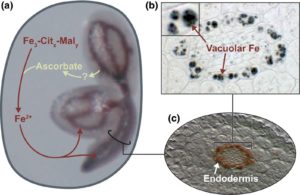 Iron (Fe) is a frequently limiting nutrient for plant growth. Iron uptake requires that plants manipulate the extracellular environment through secretion of protons, chelators and other molecules. Curie and Mari review new studies on the importance of coumarin (phenolic compound) secretion in iron uptake, the role of the endodermis, and the role of cell walls and other apoplastic spaces as reservoirs of iron, as well as how the hormones ethylene and ABA contribute to iron homeostasis. New insights into how the developing embryo secures iron from maternal tissues are also described. New Phytol.
Iron (Fe) is a frequently limiting nutrient for plant growth. Iron uptake requires that plants manipulate the extracellular environment through secretion of protons, chelators and other molecules. Curie and Mari review new studies on the importance of coumarin (phenolic compound) secretion in iron uptake, the role of the endodermis, and the role of cell walls and other apoplastic spaces as reservoirs of iron, as well as how the hormones ethylene and ABA contribute to iron homeostasis. New insights into how the developing embryo secures iron from maternal tissues are also described. New Phytol. 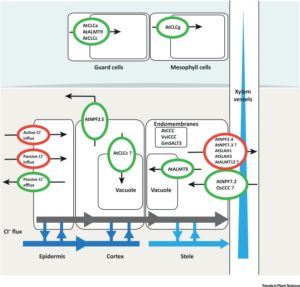 Saline soils are an ever growing problem, whether due to seawater incursions, for example in Bangladesh, or due to the rising water table in Australia. Salinity is harmful in three ways: non-specific osmotic effects, excess Na+, and excess Cl–. Of these, chloride has received the least attention. Li et al. review recent insights into the uptake and transport of Cl– into plants, including a review of chloride transporters that move Cl– into and out of the root, xylem vessels, cells and vacuoles. The involvement of ABA in Cl– homeostasis and strategies to increase plants’ tolerance to Cl– toxicity are discussed. Trends Plant Sci.
Saline soils are an ever growing problem, whether due to seawater incursions, for example in Bangladesh, or due to the rising water table in Australia. Salinity is harmful in three ways: non-specific osmotic effects, excess Na+, and excess Cl–. Of these, chloride has received the least attention. Li et al. review recent insights into the uptake and transport of Cl– into plants, including a review of chloride transporters that move Cl– into and out of the root, xylem vessels, cells and vacuoles. The involvement of ABA in Cl– homeostasis and strategies to increase plants’ tolerance to Cl– toxicity are discussed. Trends Plant Sci.  The transpiration rate of water though stomata, known as stomatal conductance or gs is one of the most critical and regulated of plant physiological processes. Buckley reviews recent progress on the development of comprehensive models of stomatal conductance, including the effect of soil moisture and air humidity, ABA synthesis and responses to light, CO2 and temperature. He also describes kinetic-based modelling of guard cell osmotic potential. Although challenges remain, Buckley concludes “Both process- and optimization-based models of stomatal conductance have become far more tractable, compact, and transparently related to measurable biophysical parameters and, therefore, more useful for forward modelling, which may soon obviate the current empirical modelling paradigm and help bridge research outcomes across scales of enquiry in plant physiology and ecology.” Plant Physiol.
The transpiration rate of water though stomata, known as stomatal conductance or gs is one of the most critical and regulated of plant physiological processes. Buckley reviews recent progress on the development of comprehensive models of stomatal conductance, including the effect of soil moisture and air humidity, ABA synthesis and responses to light, CO2 and temperature. He also describes kinetic-based modelling of guard cell osmotic potential. Although challenges remain, Buckley concludes “Both process- and optimization-based models of stomatal conductance have become far more tractable, compact, and transparently related to measurable biophysical parameters and, therefore, more useful for forward modelling, which may soon obviate the current empirical modelling paradigm and help bridge research outcomes across scales of enquiry in plant physiology and ecology.” Plant Physiol. 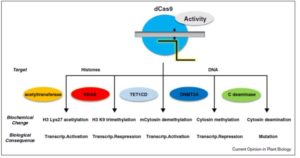 The gene-editing technology CRISPR/Cas, which introduces double-strand breaks that are repaired by non-homologous end joining (NHEJ), is best known for the promise it holds in modifying an organism’s DNA without the introduction of exogenous genes. However, as Puchta describes (Curr. Opin. Plant Biol.
The gene-editing technology CRISPR/Cas, which introduces double-strand breaks that are repaired by non-homologous end joining (NHEJ), is best known for the promise it holds in modifying an organism’s DNA without the introduction of exogenous genes. However, as Puchta describes (Curr. Opin. Plant Biol.  Limiting shoot growth is an important survival strategy for plants during times of drought; smaller leaves mean that less water is lost through transpiration and more is retained in the soil. As drought stress restricts both cell division and expansion – processes that rely on specialized microtubule arrays – factors that regulate microtubule organization and stability likely affect a plant’s ability to grow in dry conditions. However, the signaling pathways that link drought stress with changes in microtubule organization are unknown.
Limiting shoot growth is an important survival strategy for plants during times of drought; smaller leaves mean that less water is lost through transpiration and more is retained in the soil. As drought stress restricts both cell division and expansion – processes that rely on specialized microtubule arrays – factors that regulate microtubule organization and stability likely affect a plant’s ability to grow in dry conditions. However, the signaling pathways that link drought stress with changes in microtubule organization are unknown.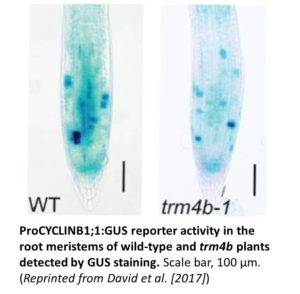 While shoot and inflorescence growth appear normal in trm4b, its primary roots are significantly shorter than wild type, likely due to reduced cell division in the meristem. Indeed, a marked reduction in mitotic activity was evident in trm4b roots compared to wild type, which was detected using a ProCYCLIN B1;1-GUS reporter line (to reveal mitotic activity) crossed into the wild-type versus trm4b background (see figure). Since m5C methyltransferases are important oxidative stress response regulators in several species, the authors investigated the response of trm4b to this stress. The mutant showed increased sensitivity to oxidative stress but not to salt stress, suggesting that TRM4B mediates the oxidative stress response in Arabidopsis. The mutant phenotypes could be due to altered m5C levels in tRNAs (leading to reduced tRNA stability) rather than in the identified mRNAs, a promising area for future study. Oxidative stress-related genes are activated in the mutant, even under control conditions, suggesting the short root phenotype of trm4b might be mediated by the partial activation of oxidative stress pathways.
While shoot and inflorescence growth appear normal in trm4b, its primary roots are significantly shorter than wild type, likely due to reduced cell division in the meristem. Indeed, a marked reduction in mitotic activity was evident in trm4b roots compared to wild type, which was detected using a ProCYCLIN B1;1-GUS reporter line (to reveal mitotic activity) crossed into the wild-type versus trm4b background (see figure). Since m5C methyltransferases are important oxidative stress response regulators in several species, the authors investigated the response of trm4b to this stress. The mutant showed increased sensitivity to oxidative stress but not to salt stress, suggesting that TRM4B mediates the oxidative stress response in Arabidopsis. The mutant phenotypes could be due to altered m5C levels in tRNAs (leading to reduced tRNA stability) rather than in the identified mRNAs, a promising area for future study. Oxidative stress-related genes are activated in the mutant, even under control conditions, suggesting the short root phenotype of trm4b might be mediated by the partial activation of oxidative stress pathways. Phosphorus (P) is an important macronutrient for crop productivity. In cereal crops like rice, about 60-85% of total plant P is allocated to grains and therefore removed from fields at harvest. Furthermore, the major form of P in the grains is phytate (C6H18O24P6), which cannot be digested by humans and monogastric animals. Phytate, therefore is excreted, resultiing in eutrophication of rivers, lakes and oceans. Phytate also forms strong complexes with metals such as zinc and iron, thereby reducing their availability. Yamaji et al. describe the SULTR-like phosphorus distribution transporter (SPDT), which controls the allocation of phosphorus to the grain. Knockout lines in rice result in decreased phosphorus in the grains but increased levels in the leaves. The authors also show that under field conditions, reduction in P in knockout lines has no effect on grain yield, seed germination and seedling vigour. (Summary by
Phosphorus (P) is an important macronutrient for crop productivity. In cereal crops like rice, about 60-85% of total plant P is allocated to grains and therefore removed from fields at harvest. Furthermore, the major form of P in the grains is phytate (C6H18O24P6), which cannot be digested by humans and monogastric animals. Phytate, therefore is excreted, resultiing in eutrophication of rivers, lakes and oceans. Phytate also forms strong complexes with metals such as zinc and iron, thereby reducing their availability. Yamaji et al. describe the SULTR-like phosphorus distribution transporter (SPDT), which controls the allocation of phosphorus to the grain. Knockout lines in rice result in decreased phosphorus in the grains but increased levels in the leaves. The authors also show that under field conditions, reduction in P in knockout lines has no effect on grain yield, seed germination and seedling vigour. (Summary by 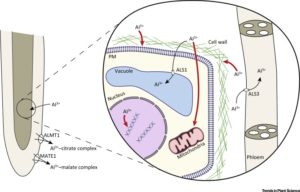 Aluminum (Al) toxicity is an important agricultural problem, limiting crop production globally. Al toxicity causes a reduction in nutrient uptake, resulting in nutritional deficiency and leading to an overall reduction in shoot biomass and crop yield. Eekhout et al. discuss Al toxicity and strategies to develop Al-tolerant plants. The identification of Al hypersensitive mutants as well as three other mutant genes that reverse the hypersensitivity of the former reveals that the DNA damage response (DDR) pathway plays a key role in Al tolerance. The discovery that DDR regulators actively stop root growth in response to Al toxicity not only pinpoints DNA as a primary target of internalized Al but also offers new strategies to engineer Al-tolerant crop plants. (Summary by
Aluminum (Al) toxicity is an important agricultural problem, limiting crop production globally. Al toxicity causes a reduction in nutrient uptake, resulting in nutritional deficiency and leading to an overall reduction in shoot biomass and crop yield. Eekhout et al. discuss Al toxicity and strategies to develop Al-tolerant plants. The identification of Al hypersensitive mutants as well as three other mutant genes that reverse the hypersensitivity of the former reveals that the DNA damage response (DDR) pathway plays a key role in Al tolerance. The discovery that DDR regulators actively stop root growth in response to Al toxicity not only pinpoints DNA as a primary target of internalized Al but also offers new strategies to engineer Al-tolerant crop plants. (Summary by